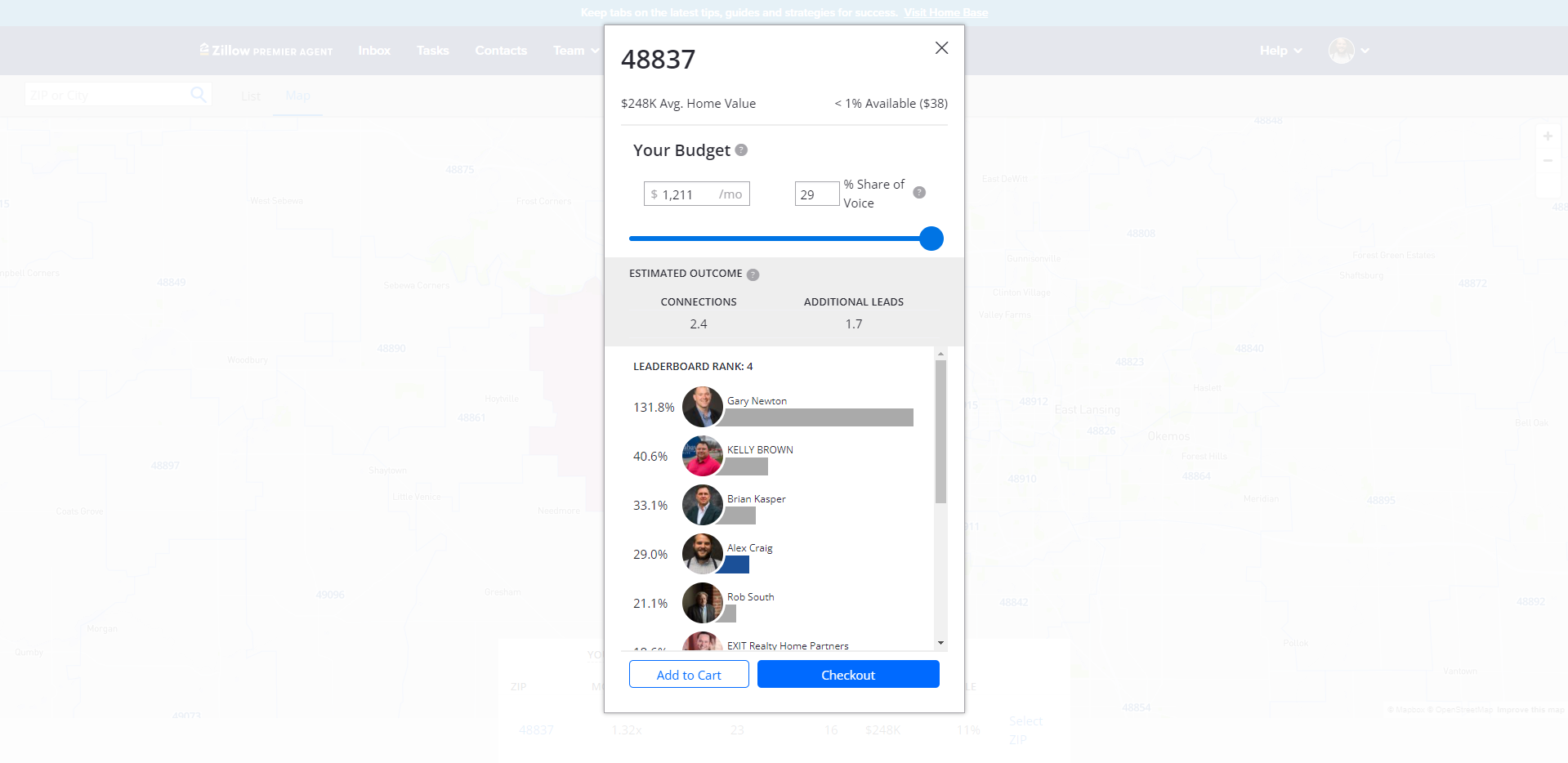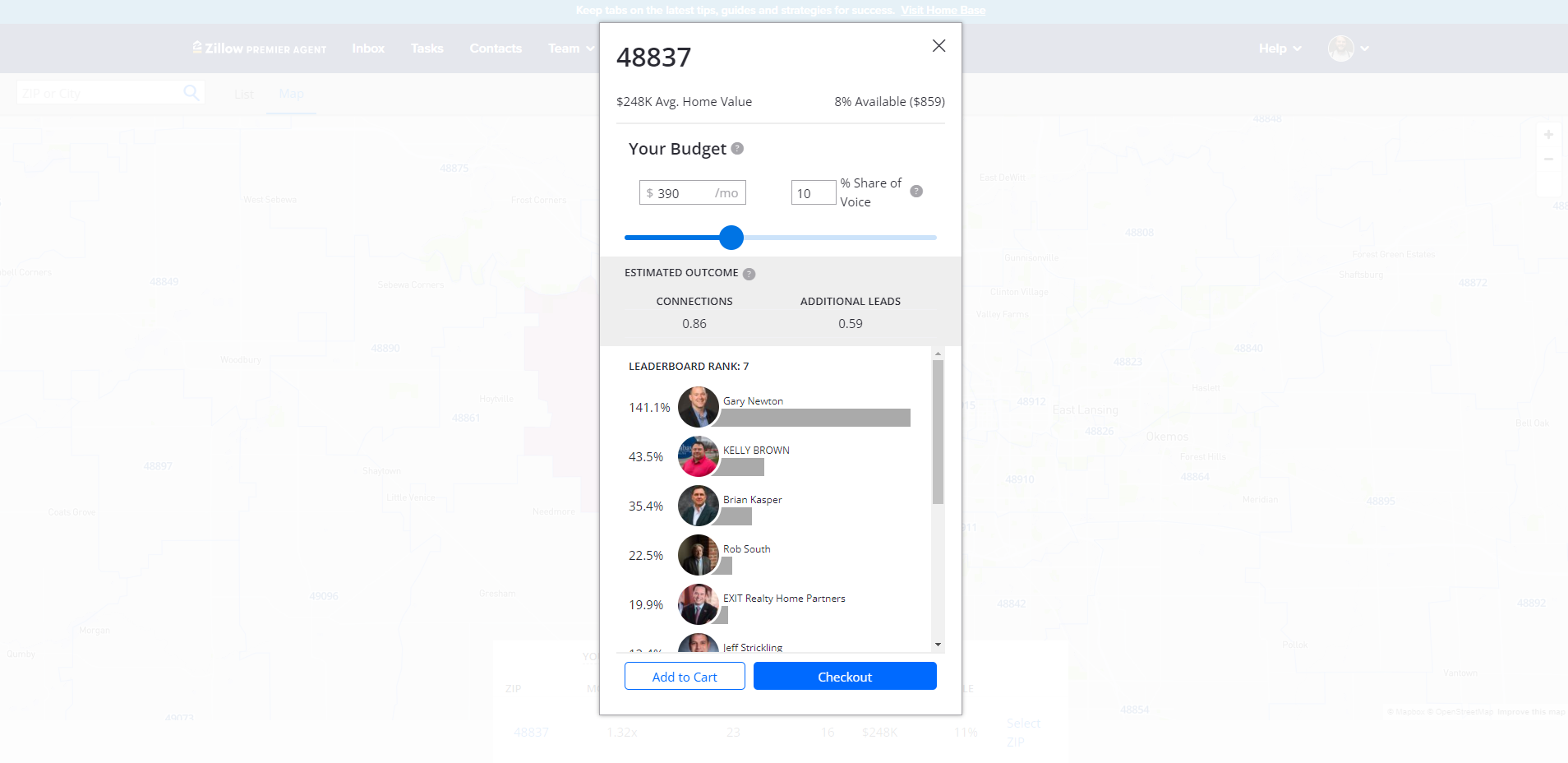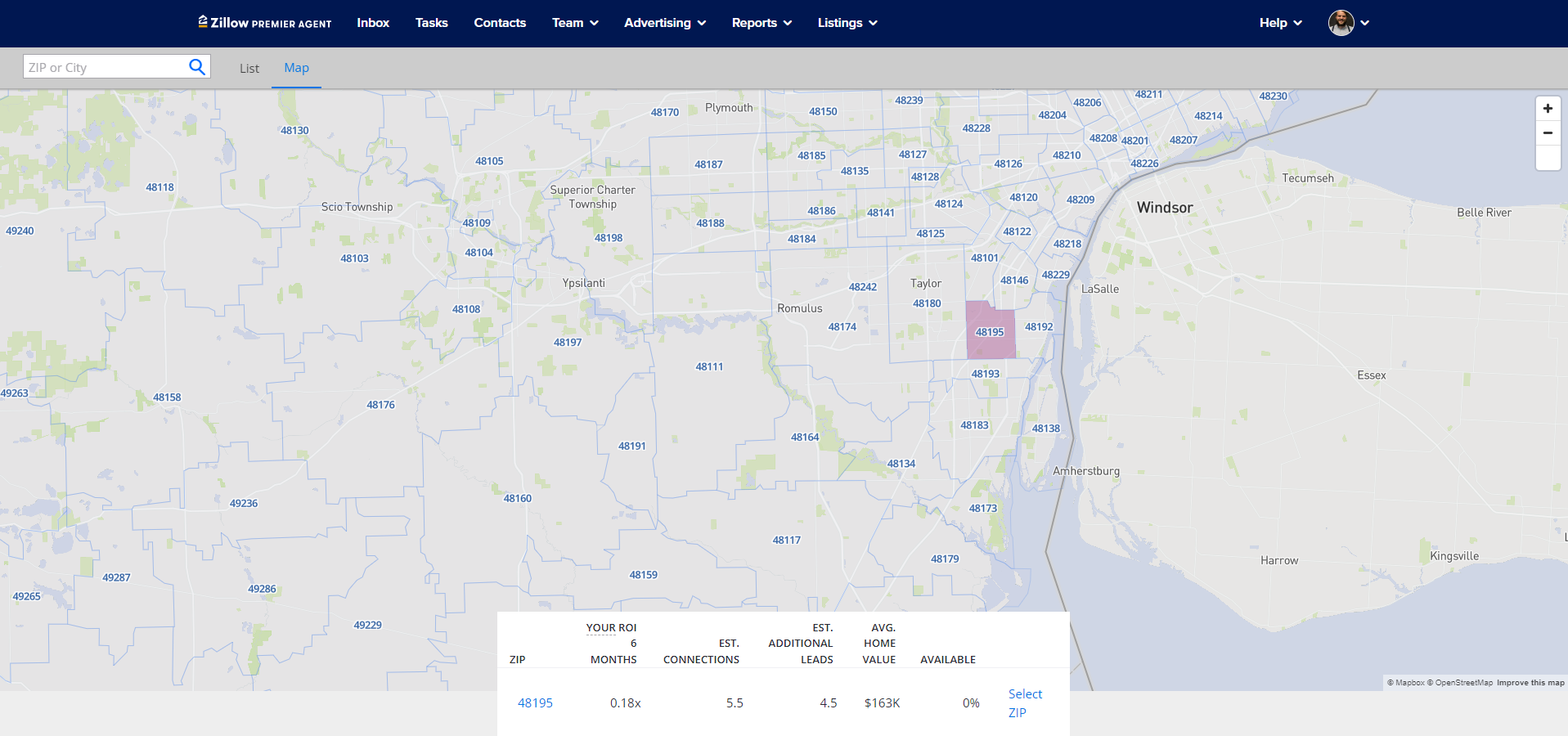Leads. Leads. Leads. You’ve either been told or have come to realize that part of your success in real estate depends on your ability to generate leads. For most, Zillow’s Premier Agent program is an obvious place to start.
Put a little bit (or alot) of money in and get Zillow leads out.
Simple…
…At least that’s the hope.
Perhaps you have exhausted your sphere of influence and database. Now you’re wondering where you can get more real estate leads.
With rising lead costs and a shortage of inventory, you may wonder, should you invest in Zillow leads in 2022?
In this post, we’ll cover how Zillow’s Premier Agent works, how much leads cost, when it makes sense to invest into Zillow leads, and how to determine how much to put into the program.
We’ll also answer the question if Zillow leads are worth it from the perspective of an individual real estate agent and real estate teams.
How Does Zillow Premier Agent Work?
Zillow Premier Agent is an advertising platform that offers agent exposure and buyer-seller leads through their family of websites, such as, Zillow, Trulia, and StreetEasy.
The program is designed to provide exposure, in terms of “impressions” that will ideally turn into connections and leads.
Understand that leads are not guaranteed.
When you sign up for Zillow Agent Premier, they are placing your ad and showing it a specific number of times in a specific zip code within a specific time frame. For example, you can purchase 5,000 impressions in one month and your ad will be shown 5,000 times.
The minimum impression count to see results that Zillow recommends is 5,000.
But where does this exposure come from? A majority of it comes from being placed as an agent on listings by non-premier agents.
Here’s an example listing. Under the section “Your Personal Guides”, you will show up.

In addition to the exposure on these listings, you will also be featured as the ONLY agent on your listings. Plus, Zillow Premier Agent offers some additional features and tools to help you convert your leads into closings.
How Much Do Zillow Leads Cost?
Zillow lead costs vary. The pricing model is a little complex, but it’s built on two main components.
- Zip Code and Home Values
- The Competition and Market Demand
The base cost of advertising on Zillow is set by the zip code and home values within that real estate market.
Areas with a higher median home value will have higher lead costs.
And vice versa.
The cheaper the home values, the lower the cost.
For example, an area in California with a median home value of $400,000 will cost significantly more than an area in Michigan with a median value of $175,000.
Second, and the confusing part, is the cost will then be influenced by the market competition. In other words, how many other real estate agents are targeting the zip code.
Zillow Share Of Voice Explained
When you set your advertising budget on Zillow Premier, you’re purchasing a certain “Share of Voice” or SOV for a given zip code. You’re able to determine how much you want this to be.
So, for example, if you purchase 29 percent SOV, that means home buyers and sellers will see you in that zip code 29 percent of the time.
Here’s an example of me targeting a zip code and requesting 29 percent share.

Your SOV is determined by your zip code, the competition, and your advertising budget.
In the example, Alex Craig could only capture 29 percent of the market share because Zillow is limiting the amount of people that can advertise within the zip code.
Zillow Lead Availability
The SOV is also a finite pie. By capturing more shares, I’m taking away some of the SOV from other real estate agents.
Take the example when I reduce my SOV to 10 percent. The first real estate agent, Gary Newman, 131.8 percent to 141.1 percent. When I reduce my SOV, his increases. As do all of the other agents on the list.

If you’re already paying for Zillow leads, it is important to realize that your share of voice increases or decreases as other real estate agents enter or exit the market.
It’s entirely possible for you to have 100 percent of the market share one month, and then drop down to 50 percent the next month.
Here’s an example: there are three agents each spending $100 who have a 100 percent share of the market. The total market percentage is 300 percent. One agent decides to increase their budget from $100 to $600. This agent would now have a 225 percent share of voice.
The other agents who kept their budget the same would now have a share of voice only 37.5 percent. To get back up to the 100 percent share of voice, they would need to match the budget of the other agent.
Thankfully, Zillow does limit the amount of money that can be spent in a zip code, otherwise, pricing could theoretically be bid up to an unprofitable level.
However, it also means that we’re limited in the amount of voice we can capture if there is a high competition. For example, in 2022, it’s common for most zip codes to have no advertising availability.
In other words, even if you wanted to advertise, you can’t.
Main Point: The more agents spend in a certain zip code, the larger their market share and a resulting decrease in voice for the other agents.
Estimate Your Zillow Lead Costs
Okay, great. So, all I’ve told you is that Zillow lead costs vary. How do you determine what Zillow leads cost in your area or the zip codes you want?
Luckily, Zillow has a nice zip code map that can help you estimate the potential cost of your leads and how many leads you might get.
You can access the zip code map inside your Zillow account.

Once you see a zip code you want, click “Select Zip” and you can begin setting your share of voice.
Take Alex Craig who is thinking about buying 29 percent of SOV for the 48837 zip code. The estimated outcome is that Alex Craig will get 1.7 leads with a total cost of 1,211 per month.

Do a little math by taking the total cost and dividing it by the amount of leads and you can get your cost per lead.
In this case, the cost per lead is $712.35.
Is this good or bad?
Well, that depends on the average home value and other factors.
You can repeat this process for any zip code where there is currently advertising space available.
I tried to do this for Los Angeles and most zip codes had no advertising space available. That’s some competition out there.
Are Zillow Leads Worth It For Individual Agents?
Armed with the potential cost of Zillow leads, we can begin to answer the original question of the article. Are Zillow leads worth it in 2022?
The short answer is possibly. It’s possible Zillow leads are worth the cost in 2022 for solo real estate agents.
Unless a real estate agent has a strong reason, aside from financially, to invest in Zillow’s real estate leads.
Zillow Premier Agent is an excellent opportunity to find serious leads and boost your production volume.
However, there is a huge difference between making money and earning money.
Personally, I hold all of my marketing dollars accountable. It’s not enough to generate a sale. I want profit. I want money I can take home at the end of the day.
Another great feature of Zillow’s zip code map is the ability to calculate your potential ROI.
Inside of your Zillow account, you can set the average commission value, your commission split, and your conversion rate of leads to closed sales.
For this, I would go through the zip codes with a best-case and worst-case scenario.
Best-Case:
- Average Commission: 3.0%
- Your Commission Split: 100.0%
- Conversion Rate: 10.0%
Worst-Case
- Average Commission: 3.0%
- Your Commission Split: 100.0%
- Conversion Rate: 3.0%
Zillow has published that their lead conversion rate tends to be around 3 to 5 percent. Of course, your results are going to be directly tied to your effort, skills, and systems.
What ROI Do I Need?
When evaluating zip codes, I don’t recommend anything with less than a 1x ROI. That would mean you’re putting a dollar in and getting less than a dollar back.
In other words, you would have been better off keeping your dollar.
Personally, I recommend a 2x ROI at a minimum. But, I prefer higher. The higher, the better of a buffer if things don’t work out like I think they will.
A two-times ROI may not be possible to target in this market and in 2022.
I would also want to make sure that if my worst-case scenario comes true, I have at least a 1x ROI. This way, I get all of my money back. I would just be out of my time from having to help a buyer or seller.
Are Zillow Leads Worth It For Real Estate Teams?
The short answer is yes, Zillow leads can be worth it to real estate teams in 2022. That’s mostly due to their ability to leverage the leads and the real estate agents on their team.
A real estate team can accept a lower ROI than an individual real estate agent can because a real estate team won’t likely have any costs associated with the lead.
For example, a solo real estate agent will want to be compensated for their time, plus generate a profit. A real estate team may forgo the profit and only compensate the real estate agent.
They might, for example, do this as a way to attract more real estate agents to their team. They will advertise and recruit to agents that they can provide them with guaranteed real estate leads.
To find acceptable zip codes for a real estate team, you will look for a 1x ROI and plug in the commission you plan to pay your real estate agent.
For these examples, I will use 50 percent as that is the industry standard for a buyer’s agent. So, your scenario may look like this:
- Average Commission: 3.0%
- Your Commission Split: 50.0%
- Conversion Rate: 3.0%
Now, a 1x ROI only works if there are no associated costs on your end with servicing this lead.
For example, if you pay a transaction coordinator to handle the file, then you’re going to need to find zip codes with a ROI that is higher than one.
It’s important to get a solid understanding of your overall cost for that lead. Not just what you pay the agent.
What Kind Of ROI Do Teams Need To Scale?
From consulting with brokerages and real estate teams, the biggest mistake I see is assuming that Zillow will allow you to scale and grow your real estate team.
A majority of the time, it turns out to be an inhibitor. It actually ends up preventing a lot of teams from growing.
To scale your real estate team, you need to acquire the right customers at the right margins and be able to service them at the right margins.
Here’s what often happens: a real estate team will take out a ton of zip codes that promise a 1x ROI or higher. They feel good about it. They will be breaking even or making a little bit of money on each deal.
To support the amount of leads and agents they have on their team, they have to upgrade their CRM technology, they need a bigger office, and they need to hire an administrator.
Essentially, the operating expenses balloon. They grow and grow. While an agent might be making some money on a deal, their profit and loss statement shows a loss.
Their infrastructure is too expensive. The sales coming in aren’t able to support the cost of the CRM, the office space, and the administrator.
This is a classic case of scaling unprofitably, despite production and revenue going up.
There are only two ways around this. First, hold your marketing dollars accountable.
Push for an ROI that is higher than 1x.
Second, offset Zillow losses with profitable marketing channels.
The 10x ROI Rule
When it comes to building a profitable and scalable real estate team, you need to hold to the 10x ROI rule.
![]()
This rule states that you need an individual marketing channel or the total of your marketing channels to produce an ROI that is at least 10x the amount of its cost.
Meaning, your marketing costs should only be 10 percent of the gross commission produced.
This rule must be followed if you’re looking at the total marketing costs of your business. The rule can be violated on an individual marketing channel so long as the total marketing cost is still 10 percent or less of gross commission income.
This standard comes from the Millionaire Real Estate Agent. Under the financial model, we are told to keep our marketing spend within 10 percent of our gross commission income.
Anything less than a 10x ROI must be put on the chopping block and evaluated. If we’re going to accept less than a 10x ROI, we need to offset the loss with other marketing channels.
A Classic Example
Here’s an example: say you do 10 sides from Zillow at an average commission value of $6,000, resulting in a total of $60,000 gross commission income. We have another 40 sides that come from our sphere of influence, resulting in a total 240,000 GCI.
The cost of Zillow is $30,000 and the cost to market to our sphere of influence is only $2,000. Our total marketing spend is 32,000 and our total GCI is 300,000.
According to the 10x rule, we fall short. Our marketing spend is a little higher than it should be given the GCI. In a situation like this, I wouldn’t beat myself up.
However, imagine if we tried to scale Zillow to 25 sides. Bringing our total GCI to $390,000 and marketing costs to $77,000. Suddenly, our ROI is only 5x.
This is a perfect example of scaling unprofitably. This business, at the end of the year, is likely to make very little profit.
They would be far better to scale back their Zillow efforts to be aligned with the first example.
The only time I would accept a less than 10x ROI is if I’m in growth mode and I expect my sphere of influence or other profitable marketing channel to catch up and compensate for my spending on Zillow. Even then, I would carefully track and manage the rate of growth so that I can manage my cash flow.
A good quickbooks accounting system will help you keep track of this data.
Zillow Flex Program
Before I move on, Zillow is rolling out their Zillow Flex Program, which I believe will make it easier for agents to achieve the ROI margins.
The Flex program is following suit in an effort to compete with other leads offering a solution where you only pay a fixed percentage if the lead closes.
This will reduce individual risk to every real estate agent. Right now, the program is only available in select markets and for select high-producing real estate agents.
Agents will also have improved cash flows under this program. They won’t have to pay out until they make money.
The downside is that if you’re on the Flex program where there is a high ROI for a zip code, it could end up hurting your margins.
It’s common for the cost to be 35% for homes around the median value of a zip code. This results in a 2.8x ROI. If you’re in a zip code getting higher than that, this program may actually be disadvantageous to you.
We will have to keep watching and monitoring it to see if it becomes the new standard for Zillow’s advertising.
Final Thoughts On Zillow Leads
Zillow leads can make sense in 2022, but you have to have solid systems and plans for converting these leads. At all times, you should hold your marketing dollars accountable.
If you’ve determined that Zillow leads aren’t for you right now, I would encourage you to reevaluate in the future.
As real estate agents move in and out of the market and the real estate market shifts, Zillow leads may make sense for you. You may be able to reach the right ROI in your desired zip codes.
At a minimum, I recommend checking Zillow leads out every year when you do your business plan. I might encourage you to do it every six months.
And just because Zillow leads might be working for you now or make sense, you should be constantly evaluating them as well. It’s not uncommon for Zillow leads to suddenly stop working and make sense for you.
Especially as lead costs continue to go up and the market becomes more competitive.
If you plan to use Zillow leads, make sure you have other lead sources developed. Hold your total marketing dollars accountable to 10x ROI and never push that number down unless you have a clear plan and understanding of growth in your business.
If you rely on only Zillow or let it become too large of a lead source, you will burn through your budget and create unprofitability.
The unprofitability will need to be offset from profits in other marketing channels, your savings, or worse, debt.
Good luck and may Zillow leads in 2022 be good for you.




